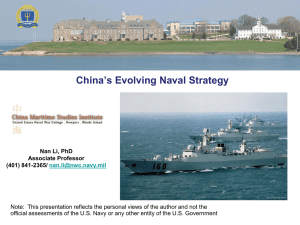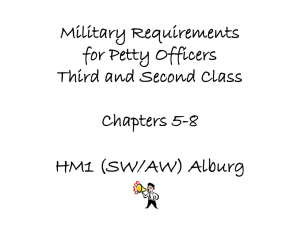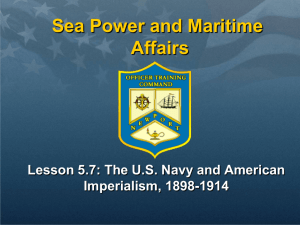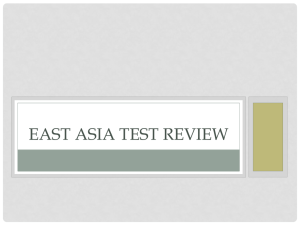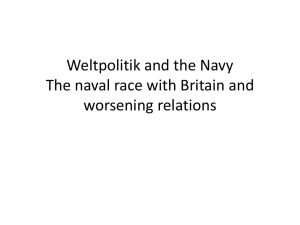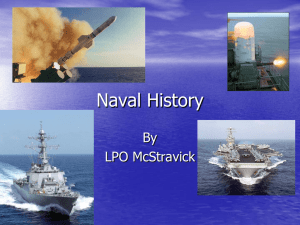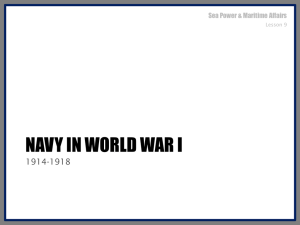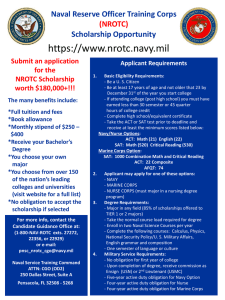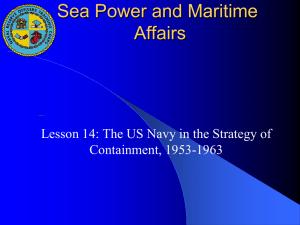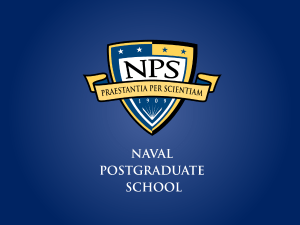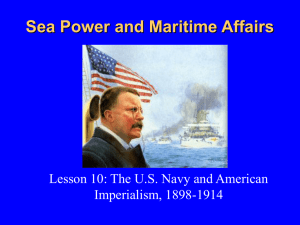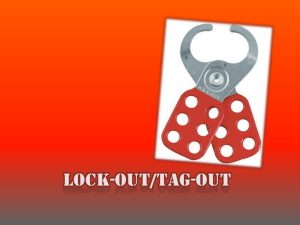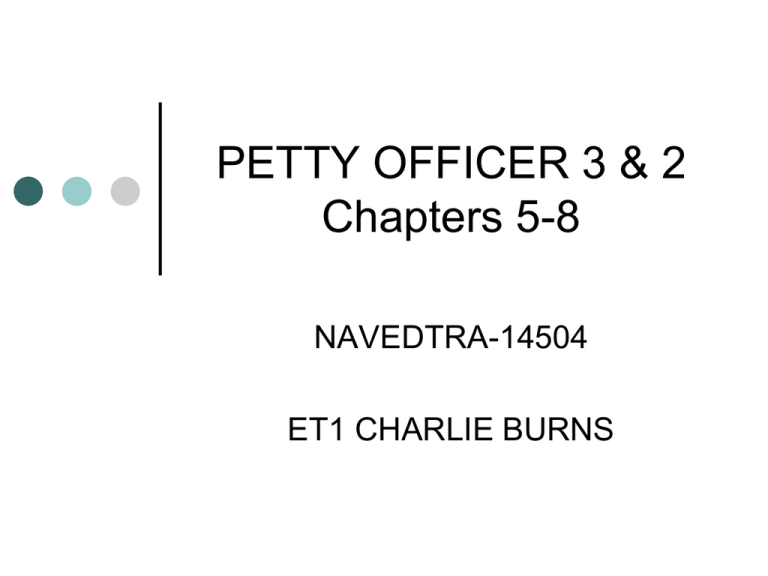
PETTY OFFICER 3 & 2
Chapters 5-8
NAVEDTRA-14504
ET1 CHARLIE BURNS
Topics
Chapter 5 – United States Military
Organization
Chapter 6 – Safety and Hazardous
Materials Information for the Petty
Officer
Chapter 7 – Supply Procedures
Chapter 8 – Military Responsibilities
and Duties
Chapter 5
United States Military Organization
I can imagine no more rewarding career.
And any man who may be asked in this
century what he did to make his life
worthwhile, I can respond with a good
deal of pride and satisfaction: “I served
in the United States Navy.”
- President John F. Kennedy
Department of Defense
President
(Commander in Chief)
Secretary of Defense
Department
of the Army
Department
of the Navy
Department
of the Air Force
CNO
Navy Major Commands
and Agencies
You
Deputy Secretary
of Defense
Office of the
Secretary of Defense
Inspector General
Joint Chiefs of Staff
Commander in Chief
The President, as the Commander in Chief,
heads the military chain of command within the
Department of Defense (DoD).
The Commander in Chief is kept abreast of all
matters affecting the ability of the DoD to
defend the United States and its allies.
What article of the Constitution provides that the
executive power shall be vested in a President of
the United States?
1) V
2) II
3) III
4) IV
2) II
Secretary of Defense
Under the President, the SECDEF, by
virtue of an executive order, has
responsibility for all the President’s
functions involving the DoD. Those
functions include the President‘s
powers, duties and authorities.
Joint Chiefs of Staff
Consists of the Chairman, the Vice
Chairman the Chief of Staff US Army, the
Chief of Naval Operations, the Chief of
Staff US Air force, and the Commandant
of the Marine Corps. The Chairman is the
principal military advisor to the President.
The Chairman holds the rank of general or
admiral and outranks all other officers of
the armed forces.
Department of the Air Force
Established on Sept 18, 1947. They
are responsible for defending the
United States through control and
exploitation of air and space.
Department of the Army
Established by the Continental
Congress on June 14, 1775. The
Army focuses on land operations.
United States Marine Corps
Established on Nov 10, 1775. The
Marines are able to fight on land, air
or sea.
Which of the following is the most senior officer in
the armed forces?
1) Commandant of the Marine Corps
2) Chief of Naval Operations
3) Chairman of the Joint Chiefs of Staff
4) Secretary of Defense
3) Chairman of the Joint Chiefs of Staff
Other Department of Defense
Agencies
Ballistic Missile Defense Organization
Defense Advanced Research Projects Agency
Defense Commissary Agency
Defense Contract Audit Agency
Defense Finance and Accounting Service
Defense Information Systems Agency
Defense Intelligence Agency
Defense Legal Service Agency
Defense Logistics Agency
Defense Security Service
Defense Threat Reduction Agency
National Imagery and Mapping Agency
Who serves as the spokesman for the
commanders of the unified combatant command?
1) Commander of the U.S. Joint Forces Command
2) Chairman of the Joint Chiefs of Staff
3) Secretary of the Army
4) Secretary of the Air Force
2) Chairman of the Joint Chiefs of Staff
Department of the Navy
Primary mission is to protect the United
States, as directed by the President or the
SECDEF, by the effective prosecution of
war at sea including, with its Marine Corps
component, the seizure or defense of
advanced naval bases; to support, as
required, the forces of all military
departments of the United States; and to
maintain freedom of the seas.
Department of the Navy
Office of Legislative Affairs
Office of Information
Office of the Judge Advocate General
Office of the Auditor General
Office of Program Appraisal
Assistant Secretary of the Navy (Manpower and Reserve
Affairs)
Assistant Secretary of the Navy (Research, Engineering,
and Systems)
Assistant Secretary of the Navy (Financial Management)
Assistant Secretary of the Navy (Shipbuilding and Logistics)
Office of the General Counsel of the Navy
Chief of Naval Operations
The Chief of Naval Operations (CNO),
under the direction of SECNAV, takes
precedence above all other officers of the
naval service.
The CNO is the Navy member of the Joint
Chiefs of Staff.
The CNO, under the Secretary of the Navy,
exercises command over certain central
executive organizations, assigned shore
activities, and the Operating Forces of
Navy.
Master Chief Petty Officer of the Navy
(MCPON)
Serves as the senior enlisted
representative of the Navy. Started in
1966 by the CNO to help with
retention. The office was formally set
up on 1 March 1967 with a tour length
of four years. The MCPON reports
directly to the CNO regarding matters
on active duty and retired enlisted
members and their dependants.
The Master Chief Petty Officer of the Navy is
assigned to what immediate office?
1) Chief of Naval Personnel
2) Chief of Naval Operations
3) Secretary of the Navy
4) Assistant Secretary of the Navy
2) Chief of Naval Operations
The Operating Forces
Naval Reserve Force
Operation Test and Evaluation Force
Naval Special Warfare Command
Military Sealift Command
U.S. Naval Forces Europe
U.S. Naval Forces Central Command
Atlantic Fleet
Pacific Fleet
The U.S. Naval Forces Central Command’s area
of responsibility includes which of the following
areas?
1) Mediterranean
2) Middle East
3) Continental United States
4) South America
2) Middle East
The Pacific Fleet’s area of responsibility includes
which of the following area?
1) Southeast Asia
2) Arctic Ocean
3) U.S. west coast
4) Both 2 and 3
4) Both 2 and 3
The Shore Establishment
Chief of Naval Personnel
Bureau of Medicine and Surgery
Naval Sea Systems Command
Naval Air Systems Command
Naval Supply Systems Command
Naval Facilities Engineering Command
Space and Naval Warfare Systems Command
Strategic Systems Programs
Naval Computer and Telecommunications Command
Naval Meteorology and Oceanography Command
Office of Naval Intelligence
Chief of Naval Education and Training Command
Naval Doctrine Command
Naval Security Group Command
Naval Legal Service Command
Naval Space Command
Naval Safety Center
Commandant of the Marine Corps
The Commandant of the Marine
Corps (CMC) commands the Marine
Corps. The commandant is directly
responsible to SECNAV for the
administration, discipline, internal
organization, training requirements,
efficiency, readiness, and total
performance of the Marine Corps.
What command plans the amount of education
and training needed by the Navy personnel to
meet manpower requirements.
1) CHNAVPERS
2) CNET
3) DIRSSP
4) COMNAVDOCCOM
1) CHNAVPERS
What command enhances the war-fighting
capability of the Navy and Marines by arming our
Sailors, Marines, and civilians with the knowledge
they need to save lives and preserve resources?
1) COMNAVSAFECEN
2) COMNAVSECGRUCOM
3) COMNAVSPACECOM
4) ONI
1) COMNAVSAFECEN
Chapter 6
Safety and Hazardous Materials
Information for the Petty Officer
…out of this nettle, danger, we pluck this
flower, safety.
- William Shakespeare
Henry IV, I.3
Safety
Safety rules and regulations concern
all of us, regardless of the job to which
we are assigned. All types of tasks,
from the simplest to the most
hazardous, have safety regulations.
We often will not observe safety
precautions unless we are fully aware
of the dangers involved.
The objective of any safety program
is to improve operational readiness.
1) True
2) False
1) True
Organizational Safety Responsibilities
Ultimate responsibility for the safety of
the unit lies with the Commanding
Officer.
Each individual plays a part in that
safety.
The Division Safety Petty Officer
reports directly to the division safety
officer in all matters concerning
division safety.
Who is responsible for mishap prevention
training and maintaining appropriate
records?
1) Executive Officer
2) Command master chief
3) Division Safety Petty Officer
4) All hands
3) Division Safety Petty Officer
Safety Council
Large commands may have a safety
organization.
As the Division Safety Petty Officer,
you may serve as the representative
of your division.
Meets monthly.
What is the purpose of the command
safety council?
1) Mandate safety policy
2) Enforce safety policy
3) Develop recommendations on safety policy
4) Conduct safety training
3) Develop recommendations on safety policy
Individual Responsibilities
SAFETY IS AN ALL-HANDS RESPONSIBILITY
1) Observe all precautions.
2) Report unsafe conditions or equipment.
3) Warn others of hazards.
4) Report any injury or ill health to your
supervisor.
5) Wear or use protective clothing or equipment.
6) Be safety conscious.
7) Always inspect equipment and attachments.
Equipment Tag-out Procedures
Post DANGER, CAUTION, OUT-OFCOMMISSION tags or OUT-OFCALIBRATION labels following
authorized procedures.
Do not remove or break posted safety
tags without proper authorization.
Tag-out Logs
Used to control the entire tag-out
procedure.
It is a record of authorization of each
effective tag out action.
Contains a copy of the main tag-out
instruction, a DANGER/CAUTION tagout index and a cleared
DANGER/CAUTION tag-out record.
After the tags are cleared and the record
sheet is filled out, where would you place
the sheet?
1) At the front of the tag-out log
2) At the back of the tag-out log in the cleared
section
3) In the index/audit record
4) In the documentation file
2) At the back of the tag-out log in the cleared
section
Hazardous Materials
(HAZMATS)
Any material that, because of its quality,
concentration, or physical or chemical
characteristics, may pose a real hazard to
human health to the environment.
Includes: Flammable and Combustible
Materials, Toxic Materials, Corrosive
Materials, Oxidizers, Aerosols, Compressed
Gases
Hazardous Materials Information
System(HMIS) is a computerized database
of material safety data sheets (MSDSs).
Occupational Safety and Health Administration
passed a regulation that requires all civilian and
military employees of the federal government to
comply with what regulation?
1) Hazardous Material Control and Management
2) Hazard Material and Refuse Management
3) Hazard Communication Standard
4) Hazardous and Toxic Material Disposal
3) Hazard Communication Standard
HAZMAT Precautions
MAKE sure the space in which you are working has adequate
ventilation.
WEAR protective clothing, goggles, respirators, gloves and other
equipment.
MAKE sure accessible fire-fighting equipment is nearby.
TAKE every precaution to prevent excessive vapors from contaminating
the air.
CHECK the labels on all containers of liquid.
WIPE up spilled solvents immediately.
AVOID contact with your eyes, skin, or clothing. NEVER swallow
solvents.
KEEP solvent containers tightly closed when you are not using them.
CHECK containers for leakage.
MAKE sure containers are empty before you discard them.
LABEL all containers used to store solvents.
READ and comply with all instructions and precautions on the label.
Most cleaning compounds do NOT
contain toxic substances.
1) True
2) False
2) False
Chemical, Biological, and
Radiological (CBR) Defense
Mission Oriented Protective Posture
(MOPP)
4 levels
Flexible to allow the CO to adapt the
requirements for protective clothing
and equipment to the degree of the
threat and working conditions at any
given time.
MOPP
Level 1 - Suspected (Issued)
Level 2 - Possible (Mask in carrier on
person)
Level 3 - Probable (Don gear)
Level 4 - Imminent (Don masks)
Readiness condition III (wartime steaming)
is set during what MOPP level?
1) 1
2) 2
3) 3
4) 4
1) 1
Damage Control Petty Officer
Making damage control closure log
entries.
Maintaining damage control fittings
and equipment.
Damage Control Closure Log
The closure log is maintained at all times,
whether the ship is in port or underway.
Shows the location where the existing
material condition has been modified. The
type of fitting; the name of who requested
permission to open or close the fitting, the
date and time the fitting was opened or
closed and the name and rate/rank of the
person granting the permission.
The damage control closure log is normally
kept on the quarterdeck in port, on the
bridge at sea, and in damage control central
(DCC) during general quarters.
Maintaining Damage Control Fittings
and Equipment
Conduct daily inspections of all spaces for the elimination of fire
hazards.
Assist officers in charge in the inspection of spaces for
cleanliness and preservation and assist in the preparation of
required reports.
Ensure the preparation and maintenance of damage control
check-off lists for all spaces under their cognizance.
Weigh portable CO2 bottles and inspect and test all fire fighting
equipment and any PMS requirements.
Ensure all other damage control equipment is in place and in
usable condition; dogging wrenches, battle lanterns.
Ensure all compartments are properly stenciled or identified by
color codes.
Ensure posting in required spaces of safety precautions and
operating instructions.
Chapter 7
Supply Procedures
Help you become familiar with the
workings of the supply department so
you can use the Navy supply system
to help you carry out your duties more
effectively.
Identify material identification (national
stock number format, etc.), requisition
documents, and material expenditures
Basic Supply Terms
Controlled Equipage - Items requiring special management control because the material is
essential to protection of life or is relatively valuable and can be converted easily for personal
use.
Logistics - The science of planning and carrying out the movement and maintenance of military
forces. Logistics involve military operations that deal with the following:
-Design, development, acquisition, storage, movement, distribution, maintenance, evacuation,
and disposition of material
-Acquisition, construction, maintenance, operation, and disposition of facilities
-Acquisition and furnishing of services
-Movement, evacuation, and hospitalization of personnel
Material - All items necessary to equip, operate, maintain, and support an activity.
Supplies - All items necessary to equip, maintain, and operate a military command, including
food, clothing, equipment, arms, ammunition, fuel, materials, and machinery of all types.
Supply - The procurement, distribution, maintenance (while in storage), and salvage of
supplies, including the determination of the type and quality of supplies.
Supply Control - The process by which an item of supply is controlled within the supply system,
including requisitioning, receipt, storage, stock control, shipment, disposition, identification, and
accounting.
Stock and Control Numbers
Stock and control numbers are used to
identify and order material in the supply
system.
The identification numbers are known as:
-national stock numbers (NSNs),
-NATO stock numbers (a variation of the
NSN)
-Navy item control numbers, and
-local item control numbers.
National Stock Numbers
Is a 13-digit number consisting of a 4-digit federal supply
classification (FSC) code number and a 9-digit national
item identification number (NIIN).
Most commonly used
The federal supply classification (FSC) number identifies an
item by commodity or description; the first two digits of the
FSC are called the FSC group (denoting the group or major
division of the commodities; ex: hardware and abrasives),
and the last two digits of the FSC are called the FSC class
(denoting the class or subdivision within a group; ex:
screws are a subdivision of the FSC group, hardware and
abrasives).
The national item identification number (NIIN) identifies
each item of supply used by the DoD and NATO.
How many digits in the NSN designate the
FSC?
1) 2
2) 4
3) 9
4) 13
2) 4
What is the most common number used to
identify material?
1) Navy item control number
2) Local item control number
3) National stock number
4) NATO stock number
3) National stock number
Important Definitions
Master Repairable Item List (MRIL) provided to identify Navy-managed
mandatory turn-in repairable items.
Consists to two basic parts; Part I - Listing
of items, Part II - Shipping addresses.
Coordinated Shipboard Allowance List
(COSAL) - Lists the equipment required for
the ship to perform its operational
assignments; Repair parts and special tools
required for the operation of these
equipments; Miscellaneous portable items
needed for the care and upkeep of the ship.
The COSAL is both a technical and supply
document?
1) True
2) False
1) True
Casualty Reporting
(CASREP)
Designed to support the CNO and
fleet commanders in the assignment
of assigned forces.
Provides up-to-date, accurate
operational status for units.
Not a substitute for, but are in addition
to and complement, 3-M data.
Four types
CASREP Continued
Initial Casualty Report (INITIAL) identifies status of the casualty and any
parts or assistance needed. Sets priorities.
Update Casualty Report (UPDATE) - used
to submit changes.
Correction Casualty Report (CORRECT) used when equipment that has been
repaired and is back in operational status.
Cancellation Casualty Report (CANCEL) used when equipment is scheduled to be
repaired during an overhaul or some other
scheduled availability.
Chapter 8
Military Responsibilities and Duties
As a vision for the future, let me just say
we will steer by the stars and not the
wake. And I see four stars of equal
magnitude in the constellation that will
guide us: operational primacy,
teamwork, leadership and pride.
- Admiral J. Johnson
Chief of Naval Operations
What is the minimum number of
paragraphs for a unit of information in
naval correspondence?
1) One
2) Two
3) Three
4) Four
1) One
The CO, OIC, or person acting in either
position is not required to personally sign
which of the following documents?
1) Those which establish policy
2) Those which change policy
3) Ship’s deck log
4) Special liberty chit
4) Special liberty chit
When is the POOW the primary enlisted
assistant to the OOD?
1) At sea
2) In port
3) On watch on the bridge
4) On watch in battle conditions
2) In port
At times deck logs may be used in which of
the following legal actions?
1) Naval courts
2) Admiralty proceedings
3) Civilian courts
4) All of the above
4) All of the above
The overall responsibility for the deck log
belongs to the
1) OOD
2) JOOD
3) POOW
4) CDO
4) OOD
In the case of a bomb threat what is the
key to disarming the situation and avoiding
catastrophe?
1) Information
2) Knowledge
3) Security force
4) MAA force
1) Information
When the pistol has a lanyard attached,
what must be done during exchange of the
pistol to the next watch stander?
1) Keep the lanyard around your neck until your relief
has positive control of the pistol
2) Keep the lanyard at your side so it won’t get in the
way
3) Keep the lanyard in your hand that doesn’t hold the
pistol
4) Detach the lanyard from the weapon during the
exchange
1) Keep the lanyard around your neck until your relief
has positive control of the pistol
Which of the following activities is NOT
considered a special evolution?
1) Weapons handling
2) Refueling
3) Diving operations
4) Mess operations
4) Mess operations
Side boys are NOT paraded during which
of the following times?
1) Between sunset and 0800
2) Meal hours
3) General drills
4) All of the above
4) All of the above
The heavy weather bill will be placed in
effect if the forecast indicates a hurricane
approaching.
1) True
2) False
1) True
When handling a thermometer, touching
the lower part of the glass containing the
liquid will not effect the temperature
reading.
1) True
2) False
2) False
Winds at 39 to 54 miles per hour indicate
what warning condition?
1) Small craft
2) Gale
3) Storm
4) Hurricane
2) Gale
As Petty Officer of the Watch you are NOT
responsible for personnel throwing trash
over the side into the water in your
presence.
1) True
2) False
2) False
How many minutes before sunset should
the ship’s anchor lights be tested?
1) 60
2) 30
3) 20
4) 15
2) 30
Which of the following factors will
determine if a PO3 is assigned as a
section leader?
1) Size of the command
2) Number of personnel assigned to your duty section
3) Both 1 and 2 above
4) Number of the departments in the command
3) Both 1 and 2 above
Which, if any, of the following
responsibilities belong to the police petty
officer?
1) Apprehending violators
2) Keeping the quarterdeck clear of unauthorized
personnel
3) Serving as court liaison
4) None of the above
4) None of the above
After apprehending members of the
opposite sex, what should be done as
soon as possible?
1) Communicate immediately with headquarters for
instructions
2) Request a member of the same sex to make the
apprehension
3) Request a member of the same sex to interrogate
4) Interrogate apprehended member yourself
1) Communicate immediately with headquarters for
instructions
Which of the following entities make up a
platoon?
1) Two or more squads
2) Platoon headquarters
3) Guide
4) All of the above
4) All of the above
For quick time, at the command MARCH,
step off smartly with the left foot and
continue the march in steps of what length
in inches?
1) 25
2) 30
3) 35
4) 40
2) 30
As you face a formation, the tallest person
should be in which of the following
positions?
1) Middle of the formation
2) On your right
3) On your left
4) End closest to where the inspecting party will arrive
3) On your left
An inspection is more informal than
quarters.
1) True
2) False
2) False

